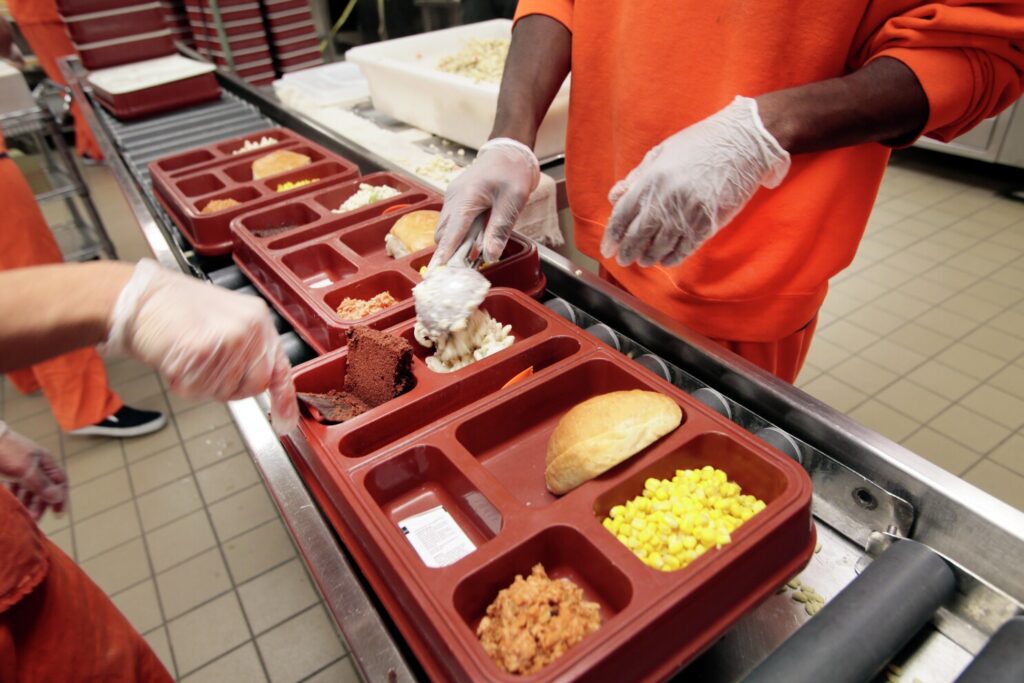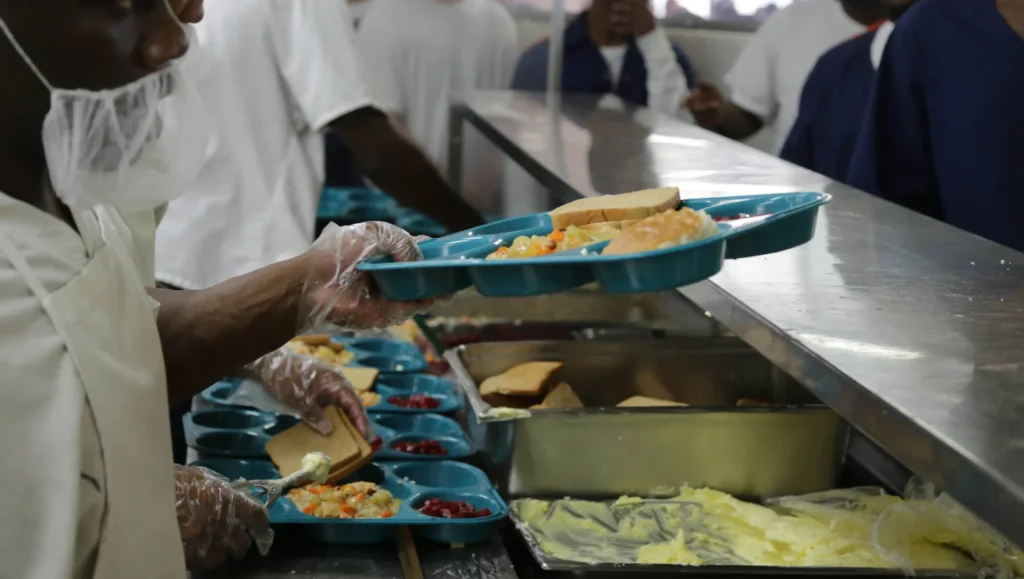What’s in a Prison Meal?

We’ve all seen television shows and movies depicting the kind of food that inmates get in prison, and for the most part, it’s not very appealing. However, the truth of the matter is that the Federal Bureau of Prisons is obligated to provide three meals that are nutritionally sound every day for inmates.
Meals are served to inmates in the general population in a dining room where everyone partakes of their meals.
This is basically a large cafeteria including a number of tables and a serving area. These meals may not be gourmet food, but they will always be nutritionally adequate, and they will ensure that all inmates are prevented from starving or going hungry. Most meals are hot and are similar to what people on the outside might eat, although generally of a lesser quality. For breakfast, an inmate can expect hot or cold cereal, milk, and possibly a donut or Danish.
Afternoon and evening meals might consist of tacos, burritos, hamburgers, hotdogs, or lasagna. In addition to the primary entree being served, most federal prisons also include a salad bar service area where inmates can get beans, peas, and other greens to supplement the prison food they’re served.
Do prisoners get enough food?

Prison food is primarily prepared by inmates who are assigned to the Food Service Department in a particular facility. These inmates will do all the cooking and serving, although they are under constant supervision by prison guards who have at least some experience with food service.
Prisoners have no choice in the food that gets served to them, and they will receive the same portions from their fellow inmates whenever they are in a serving line. Serving sizes tend to be highly standardized for each meal, with the lone exception being the salad bar, which operates on a self-serve basis.
If a prisoner is still hungry after eating the designated meal for that time frame, they don’t have the option of asking for more. Most federal prisons are equipped with ID card scanners that ensure prisoners only eat a single meal. Anyone who is caught trying to go through the line twice will be at risk of being written up in an incident report for stealing food.
However, if a prisoner has been at a facility long enough to establish a trust fund account, they will have the option of purchasing food from the prison. Prisoners who have money might also be able to buy foods made and sold by their fellow inmates, such as burritos or homemade pizzas.
This will be the only way to make up for a meal that an inmate might consider inadequate, but the inmate will need to have enough money or enough funds in their trust fund account to purchase the extra food. So, even though prisoners may not be served the highest quality food, and they may not get all they want, they will still have the option of supplementing prison meals with snacks and other foods which the prison might make available to them.
The pecking order in prison cafeterias

When prisoners enter a cafeteria to eat, one of the three designated meals each day, the layout of the cafeteria can get pretty territorial. As often as not, sections tend to be formed where you will see mostly white inmates, black inmates, and other tables dominated by specific groups or gangs.
It can be a major mistake to sit at any table where you don’t have the blessing and support of the gang which controls that table. Any inmate who is unsure of where to sit would be well advised to ask a cellmate about where the right table might be. You can usually find out the information you need by checking with someone who happens to be in your ethnic group, your geographic region, or someone who’s just been around long enough to know the ropes.
If you’re a new inmate and you happen to sit at the wrong table, it usually will not lead to any kind of incident the first time you do it. Once you’ve been informed, you’ll be expected to sit at the right table from that point onward. Prison life can be difficult enough without raising conflicts with other inmates, so it’s best to avoid anything that might develop into a conflict while serving your time.
Prison meal requirements in the US

Prison food has gradually improved over the years, to the point where all inmates are served nutritious and healthy meals, even if they don’t get the best tasting food, or the finest cuts of meat. In 2016, federal prison facilities began offering prisoners vegan meals for all three meals of the day. You can find out more here.
In America, inmates’ rights to nutritional meals are protected by Constitutional Amendments, which is a show of how seriously the whole issue is taken by government officials. While requirements may vary from federal to state prisons, and among the states themselves, there are some standards that have to be met for meals in prison.
Each meal, a prisoner must be provided with at least two to three ounces of meat, three-quarters of a cup of salad, three-quarters of a cup of starch, and half a cup of vegetables. When these requirements cannot be met with each meal, it is incumbent upon the facility to make prison spreads available to inmates.
Prison spreads are foods that are purchasable from the prison, for instance, fast-food type offerings like tacos or pizza. In this way, all inmates receive at least adequate nutrition and sustenance, and when they don’t like what’s being offered in the main prison meal of the day, they’ll usually have the option of purchasing other foods from the commissary to supplement their meal.
Why are prisoners provided good meals?

It makes good sense for prison facilities to provide healthy meals with adequate nutrition to inmates. If prisoners were consistently given poor quality foods to eat, it’s much more likely that there would be disease rampant among inmates, and it could be a source of major discontent among them as well.
That would all go to increase healthcare costs and prison management costs that the taxpayers would be obliged to foot the bill for. If food were to be provided on the basis of cost-cutting, there’s no question that malnutrition would abound in prison facilities, and that would force taxpayers to pay even more money for healthcare. This being the case, putting healthy, nutritious food on the table for inmates is clearly the best policy for prison facilities.



